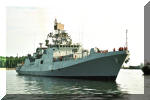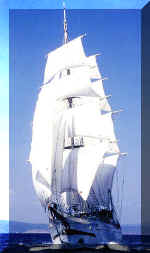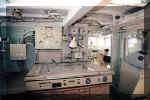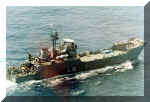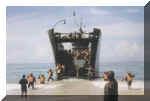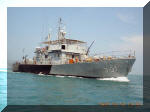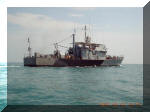- Details
-
Category: Ships
-
Written by Landing Ship Tank (Medium)
-
Hits: 45392

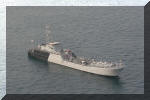
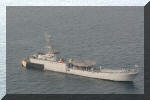
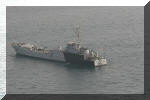
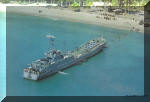


Vessel Type: Amphibious Warfare Vessel or Landing Ship Tank (Medium) - LST(M).
Names & Pennant Numbers with Commissioning Dates and Places:
INS Cheetah L18 (February 1985 - Gdynia, Poland)
INS Mahish L19 (04 June 1985 - Gdynia, Poland)
INS Guldar L21 (December 1985 - Gdynia, Poland)
INS Kumbhir L22 (November 1986 - Gdynia, Poland)
Names & Pennant Numbers with commissioning dates and places:
Ghorpad L14 (21 December 1974 - Gdynia, Poland) - decommissioned on 11 January 2008
Kesari L15 (15 August 1975 - Gdynia, Poland) - decommissioned on 08 May 1999
Shardul L16 (24 November 1975 - Gdynia, Poland) - decommissioned in June 1997
Sharabh L17 (27 January 1976 - Gdynia, Poland) - decommissioned on 14 July 2011
Displacement: 1120-1125 tons standard.
...................1150 (773I) & 1190 (773IM) - tons full load.
...................1324 tons maximum load for 773IM.
Dimensions: Length (Overall) - 81.32 metres.
................Length (Between Perpendiculars) - 75.95 metres.
................Draught - 1.3 metres (extreme bow and 2.58 metres (stern).
................Breadth - 9.3 metres.
................Depth - 5.2 metres.
Main Machinery: Two Soviet Kolomna 40-D two stroke diesel engines totalling 4400 bhp sustained and 2 shafts.
Maximum Speed: 16 knots (contract speed).
Fuel: 115 tons (185 tons overload).
Maximum Range: 1200 nautical miles at 16 knots.
.......................1800 nautical miles with maximum fuel load at 16 knots.
.......................3000 nautical miles at 12 knots.
Complement: Design complement - 5 Officers, 16 Petty Officers and 24 Ratings. In regular practice, it is normal to have 6 Officers and 60 Sailors.
Military Lift: 196 tons including five MBTs (Main Battle Tanks) plus 180 troops, including vehicle crews.
Radar: Navigation; One Polish Type SRN 7453 radar at I-band frequency.
.........................One unspecified commercial navigation radar.
.........Fire Control; Refer to 'Weapons' sub-section.
Weapons: Two AK-230 (twin) 30mm gun mountings with a single MR-104 (Drum Tilt) radar at H/I-band frequency. Some vessels have this particular radar removed and the guns are instead controlled by the Kolonka optical sight.
Anti-submarine armament comprises of two Polish Type WM-18A 140mm 18-tube rocket launchers.
Helicopters: One helicopter platform (in Type 773IM) for the HAL Chetak helicopter.
Comments: These vessels are built by Poland's Stocznia Marynarki Wojennej or Naval Shipyard Gdynia in two batches of four on direct order from the Indian Navy. The vessels were commissioned in Gdynia, Poland and sailed for India with Indian crews. The commissioning CO of the Ghorpad, Sushil Kumar, was later to become the Chief of Naval Staff. The first four are Type 773I (I for India) and the second batch, with helicopter decks, are designated as the Type 773IM (M for modified). The first three vessels of the Type 773I series have been decommissioned. The first batch commissioned as the 4th Landing Ship Squadron based at Vizag, while the second batch constitutes the 5th Landing Ship Squadron of the Andaman Flotilla at Port Blair. It was announced in mid-2002 that Kirloskar Oil Engines Limited (KOEL) is to re-engine the four Type 773IM LST(M) with license built SEMT-Pielstick 6PA6 L280 engines with Naval Shipyard Gdynia acting as technical consultant. Other details have not been released.
Vice Admiral Raman Prem Suthan, Flag Officer Commanding-in-Chief Eastern Naval Command, stated that the Ghorpad had served for 9,000 hours at sea covering a total distance of 166,000 nautical miles during its 33 years of service. Lieutenant Commander Anil K. Tomer, who served as the last Commanding Officer of the Ghorpad, described her as the 'grand old lady' who has great accomplishments to her credit. Even during her last days, she was fighting fit. Commander M.V. Raj Krishna, who had commanded the ship between May 2005 and June 2006, described the decommissioning as a nostalgic moment.
- Details
-
Category: Ships
-
Written by Survey Ship
-
Hits: 16113



Vessel Type: Survey Ship.
Names & Pennant Numbers with commission dates:
INS Sandhayak J18 (14 March 1981)
INS Nirdeshak J19 (04 October 1982)
INS Nirupak J14 (14 August 1985)
INS Investigator J15 (11 January 1990)
INS Jamuna J16 (31 August 1991)
INS Sutlej J17 (19 February 1993)
INS Darshak J20 (28 April 2001)
INS Sarvekshak J22 (14 January 2002)
Displacement: 1929 tons full load.
Main Machinery: Two diesel engines with 7720 hp sustained. Also has two shafts which has active rudders.
Maximum Speed: 16 knots.
Maximum Range: 6000 miles at 14 knots.
.......................14,000 miles at 10 knots.
Complement: 178 (incl. 18 officers) + 30 scientists.
Weapons: 1 or 2 Bofors 40mm/60 guns.
Countermeasures: ESM; Telegon IV HF D/F.
Radar: Navigation; One Racal Decca 1629 radar at I-band frequency.
Helicopters: One HAL Chetak.
Comments: Fitted with a telescopic hangar. The first six vessels have three echo sounders, extensively equipped laboratories and carries 4 GRP survey launches on davits amidships. Painted white with yellow funnels. An active rudder, with a DC motor gives speeds of up to 5 knots. First three vessels (J18, J19 and J14) are based at Vizag and have been used as troop transports. J15 is based at Mumbai and J16 and J17 at Kochi. The last pair were laid down in May and August 1995, and are to have a secondary role as casualty holding ships.
